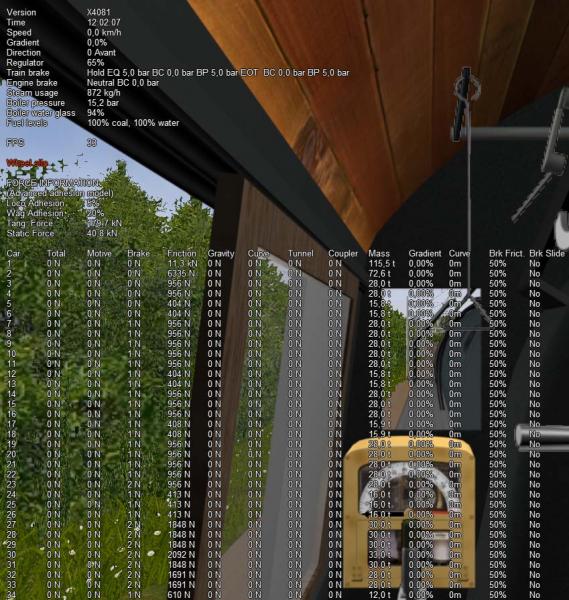 ErickC, on 28 February 2018 - 12:11 PM, said:
ErickC, on 28 February 2018 - 12:11 PM, said:
Oh, I deleted the clip. I also deleted all of the default track sound clips because they're garbage.
More general answer :
In Europe, most of steam engines had a FoA < 4 for a simple reason : axle load was generally limited to 20 metric tons/axle (rarely 22 or 23 on a few lines ). The tested engine : 141 R was, in fact, an adaptated and improved version of light 141 USRA, delivered in France between 1945 and 1947 by Alco, Baldwin, Lima and MLW. So, in calculation of adhesion, isn't FoA influency widely overestimated, essentially because most of conceptors worked only on American locomotives, on which axle load may reach 30 t/axle ? In France, 141 R hauled coal trains from North to Paris suburbs with a load of around 1000 to 1200 met.tons on an itinerary with some steps approaching 1 %. Slowly, but surely, and I can ensure that North of France climate is not as dry as Nevada's one !! :p . As a child, I saw so many of these trains to affirm it's a fact !! On the French Riviera, where it also rains sometimes, they hauled the famous "Mistral" with an admitted max load of 800 metric tons, with a perfect regularity ! And what to say about our "Pacifics" whose FoA was around 3, authorized tu haul express up to 550 met.tons on Paris to Cherbourg line (Normandy... where it doesn't rain very much, but very often...::). So, I did an .eng giving, "on the sheet of paper", a reasonable adhesion. Curtius-Kniffler parameters are adapted to adherent mass (in fact, "ORTSDriveWheelWeight" is totally inoperative, didn't you notice it ?). MaxTractiveEffort is calculated on a basis of 75% cutoff and regulator wide open. In these conditions, answer is double :
- First hypthesis is that there is a mistake in calculation mode (wrong factor, unit conversion errors...)
- Second hypothesis is that a too rigourous approach of adhesion problems dwells to such complex calculations that wheelslip is the "default solution", by overcharge of processor...
The way by which steam modelzation has been approached is what we call in French "une usine à gaz" (no possible translation, but it means that anecdotic parameters have been taken in consideration with a priority against more important factors..).
When a railway director had to determinate a maximal load for an engine - let's take our 141 R - he started from its adhesion mass : 80 metric tons, and estimated that a wet rail has tipically an adhesion around 0.14. 80*0.14 = 11.2 metric tons, let's say around 110 kN. With 110 kN, taking in account inerty of friction wheelboxes and mechanism, on a step of 1 %, you can start with around 950 metric tons load
without sanding, even if it's better to sand rail to avoid little wheelslips. Calculation is as simple as this ! And it's not me who explains this, but specialists like André Chapelon or Nigel Gresley...
Cylinder cocks were open, to allow not to apply the whole effort on wheels (they are completely unefficient, except for esthetic reasons, under OR...), ans I must precise that sanding is applied just
BEFORE starting, because there is no interest to sand the rail behind the wheel you try to move...!!!
It remains that starting an heavy train by poor adhesion remains - and must remain - difficult.. But not impossible in the limits of reasonable physical parameters.
I also think, and that was a good idea, indeed, that acceleration of wheel is taken in account to minimize tractive effort. Well, but I agree with many to find its influence is excessive, this remark being valuable for all types of engines... With modern railcars, it may grow up to almost 20 % of initial effort, even with high coefficient of adhesion... Isn't it a bit too much ? Must say that having a little experience on driving railway engines, I know that you never must apply full power roughly.. but only at low speeds ! At 120 km/h (75 mph), a "loss by slip" of 10 % is clearly excessive on dry rail.
Best regards,
Jean-Paul
 OR_141R511.eng (36.84K)
OR_141R511.eng (36.84K)

 OR_141R511.eng (36.84K)
OR_141R511.eng (36.84K)


 vince, on 26 February 2018 - 03:34 PM, said:
vince, on 26 February 2018 - 03:34 PM, said:

 vince, on 26 February 2018 - 07:04 PM, said:
vince, on 26 February 2018 - 07:04 PM, said:
 Jean-Paul, on 27 February 2018 - 09:52 AM, said:
Jean-Paul, on 27 February 2018 - 09:52 AM, said:
 SP 0-6-0, on 27 February 2018 - 12:30 PM, said:
SP 0-6-0, on 27 February 2018 - 12:30 PM, said: Jean-Paul, on 26 February 2018 - 03:16 PM, said:
Jean-Paul, on 26 February 2018 - 03:16 PM, said: Jean-Paul, on 26 February 2018 - 03:54 PM, said:
Jean-Paul, on 26 February 2018 - 03:54 PM, said: Jean-Paul, on 27 February 2018 - 09:52 AM, said:
Jean-Paul, on 27 February 2018 - 09:52 AM, said:

 ErickC, on 27 February 2018 - 10:41 PM, said:
ErickC, on 27 February 2018 - 10:41 PM, said:

 ErickC, on 28 February 2018 - 12:11 PM, said:
ErickC, on 28 February 2018 - 12:11 PM, said:
 Jean-Paul, on 28 February 2018 - 10:07 PM, said:
Jean-Paul, on 28 February 2018 - 10:07 PM, said:
 steamer_ctn, on 01 March 2018 - 02:29 AM, said:
steamer_ctn, on 01 March 2018 - 02:29 AM, said:

 Jean-Paul, on 01 March 2018 - 11:14 AM, said:
Jean-Paul, on 01 March 2018 - 11:14 AM, said: